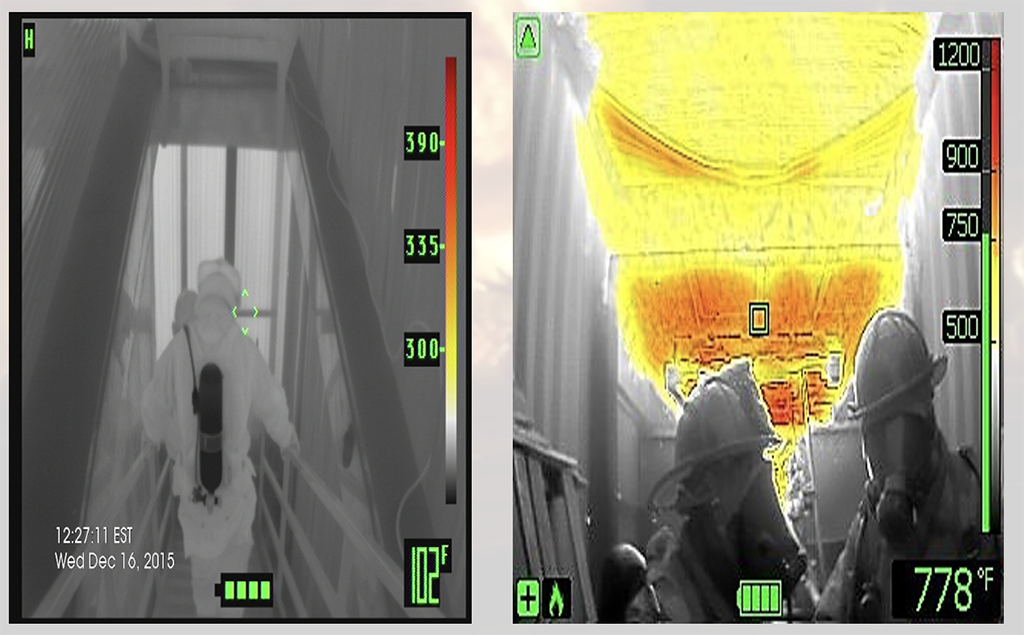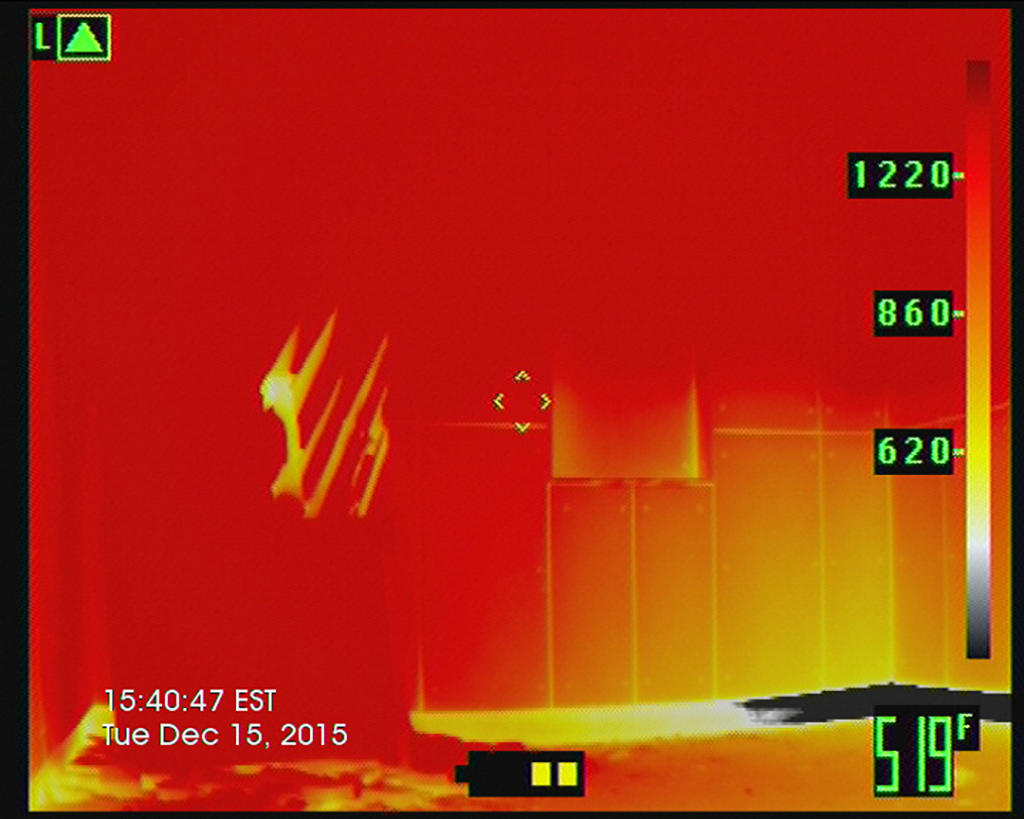BY JOSEPH DeVITO
A FIREFIGHTER must know how a tool works to use it properly. Imagine having someone hand you a halligan for the first time, with the verbal instruction to force a door. This would simply not happen. So why does it happen with thermal imaging cameras (TICs), which can be used in many different situations? TIC training usually involves turning the camera on, changing the battery, and turning it off.
Let’s start with the basics. A TIC measures the intensity of infrared (IR) thermal radiation by putting it onto a screen for us to interpret. Thermal radiation is out there but we cannot see it. A radio takes sound waves and makes them audible. A TIC does the same thing with thermal radiation:
It takes the heat waves and puts them on the screen for us to make intelligently aggressive decisions with.
Emissivity is an object’s ability to emit IR energy. A mirror has an emissivity of zero and a black box used to calibrate the TIC has an emissivity of 1.0. Organic and painted surfaces have an emissivityof approximately 0.95, which is around where TICs are set, since that is what you are looking for. The lower the emissivity, the more reflective that item will be. The higher emissivity, the better the absorption of energy will be.
Transmissivity is the ability of IR energy to move through an object. Water has poor transmissivity. Glass has poor transmissivity. While we cannot see through windows, we can look for clues and cues like window frames. Gases have good transmissivity. We can use our knowledge that thermal energy moves well through gases in flow path recognition.
Insulators, such as blankets, can hide an active emitter. If a frightened child is hiding under a blanket, the image on the TIC will be unrecognizable. This is sometimes called an anomaly. If you see a big bundle on a bed, you should investigate that anomaly. The child is still giving off heat but because the insulator is holding the heat in, you would not be able to see the child on the TIC.
A TIC Review
- The optics system has a field of view.
- The field of view is important to understand.
- A human’s field of view is 140 x 135 pixels, while a TIC’s field of view averages about 51 x 38 pixels.
The TIC: A Breakdown
Detector. The detector is the most critical part of the camera. It detects and converts heat signals from the optics. It then puts the temperatures into a focal plane array (FPA). You may recognize this as the color bar on the side of the TIC display screen.
Refresh rate. Human eyes have a refresh rate of 30 Hz. When we move or get up too quickly, we close our eyes to reset ourselves. Your camera does the same thing. When you move the camera too quickly, or faster than what the refresh rate can keep up with, the lens shutter drops down to reset the camera. This reaction by the TIC is called shuttering. The picture will freeze while you are still moving the camera. It is important to resume your scan back to where the TIC initially shuttered so you do not miss anything in your scan.
Resolution. Some awareness-level TICs and many older TICs have a resolution of 160 x 120 pixels. This camera could recognize a victim’s hand from seven feet away. Considering that the average bedroom is currently 10 feet x 10 feet or 12 feet x 12 feet, that is just not good enough. The newer cameras have a resolution of 320 x 240 pixels, which identifies a victim’s hand from 15 feet away. This is now suitable, as it can cover a standard bedroom.
Some different models, or tri modes, have a resolution of 364 x 288 pixels.
This resolution can identify a victim’s hand from 20 feet away. Note that these cameras have a high, medium, and low mode. As technology improves, so will the resolution of our cameras.
Display. The display is where we see a pixeled temperature thermograph of the scene we are looking at. Every camera is different as far as temperatures, mode changes, and colorization. Be sure to review your camera for these details. One factor that is the same across the board is that white is where the heat starts, and white is still hot. Beyond white, the color shifts to yellow, orange, then red. By following this “map,” you can follow the flow path right to the fire. If we see white thermal waves moving through a room, we can expect the next color to be yellow. This shows us the flow path.
Thermal contrast. When you’re dealing with the display, it’s important to understand thermal contrast. This concept is about how well items stand out compared to the environment they are in. For example, if you are a firefighter and you’re 100°F and you are in a room that is 100°F, you will not be identifiable on the TIC because you have no contrast. The temperatures are the same. If you, at 100°F, enter a 70°F room, you will be bright white in the camera, as you are that much warmer than your surroundings.
On the other hand, if you are a 100°F firefighter and you enter a 300°F room, you will be dark gray in the room because you are now cooler than your surroundings. This is called thermal inversion.
The object’s shade changes based on the environment, not based on its own temperature. So, in a search, something that’s normally bright white in fake smoke or the day room may now be dark gray in the fire room (photo 3).

3. In the photo on the left, the firefighter Is dearly warmer than the environment, as he Is white hot. On the right, the firefighters’ helmets appear white. The helmets are reflecting the heat. Meanwhile on the right, their gear is darker—and gray—compared to the gear on the left.
Spot temperature measurement. Also called the direct temperature measurement, this is the temperature number based on the crosshairs in the middle of the screen. This temperature only indicates surface temperatures. This is good for motors, electric, and engines—but not firefighting. This may come as a surprise, but the reason is that the convection waves move through the area they’re occupying faster than walls can absorb the heat. The FPA can show orange convection waves over 500°F, but the spot temperature or direct temperature measurement may only read 128°F because the convection waves are moving through the room too quickly (photo 4). The new National Fire Protection Association 1801, Standard on Thermal Imagers for the Fire Service (2021 edition), removed the spot measurement from the TI “Basic” mode, which is the mode used in firefighting and the mode that the TIC is in when it is turned on.

4. Looking at this thermograph, it is difficult to believe that this room is only 519°F. This is why it’s important to avoid using spot temperature in a fire. The actual temperature we should be looking at is red, which is over 1,200°F.
Get Your Gains
When you turn on your camera, it starts in “high gain” mode. The screen will show all objects in grayscale. Darker is colder and brighter is warmer. Temperatures are under 300°F. This gain focuses more on objects than heat. Objects will be more well-defined and easier to interpret.
“Low gain” mode is when the environment is over 300°F. Depending on your camera model, you will start to see colorization at over 300°F or over 500°F. This gain focuses more on heat than objects, so victims and objects will be more difficult to differentiate.
Practice, Practice
The more you use the TIC, the better you will be at using it. Use it on the stove, use it on the barbecue, use it on your campfire. Repeated use will give you a better understanding of its mode changes, colorization, temperatures, using the FPA, and knowing how to scan without having the TIC shutter on you.
JOSEPH DEVITO is an interim battalion chief at the Fort Myers Beach (FL) Fire Department. He has been with this department for 17 years, with 28 years in public service. This includes volunteer and EMS transport services. He is Level 1 Infrared Certified and holds the fire officer designation at the Center of Public Safety Excellence.


